Knowledge, attitudes and practices concerning breast cancer, cervical cancer and screening among healthcare professionals and students in Mogadishu, Somalia: a cross-sectional study
Lucas Walz1*, Deqo Mohamed2*, Adam Haibah2, Nikhil Harle3, Samir Al-Ali3, Ayan Aden Moussa4, Jude Alawa5, Mohamed Abdullahi Awale4† and Kaveh Khoshnood1†
1Yale School of Public Health, Yale University, New Haven, CT 06510, USA
2Hagarla Institute, Mogadishu, Somalia
3Yale College, Yale University, New Haven, CT 06520, USA
4SIMAD University Faculty of Medicine and Health Sciences, SIMAD University, Mogadishu, Somalia
5Stanford University School of Medicine, Stanford, CA 94305, USA
*These authors contributed equally as first authors
†These authors contributed equally as senior authors
Abstract
Introduction: Somali women face exceptionally high mortality and incidence rates from both breast cancer (BC) and cervical cancer (CC). They experience the highest age-standardised BC mortality rate in Africa and an age-standardised BC incidence rate of 41.7 per 100,000 women. Somalia’s second-highest cancer-related mortality and incidence rates are due to CC, both behind BC. It is critical to identify the underlying factors that may influence healthcare workers’ management of both cancers. At present, there is a lack of evidence regarding providers’ knowledge of these two cancers and their screening in Somalia.
Methods: A cross-sectional questionnaire was administered with a purposive sampling strategy to 469 healthcare professionals and students and was completed by 405 (86%). Healthcare workers were recruited from Mogadishu-based hospitals.
Results: One hundred and ninety-seven healthcare professionals and 207 students completed the survey and were included in the analysis. 89% and 73% of respondents demonstrated good knowledge of BC and CC, respectively. Only 46% knew that a vaccine could prevent CC, and 89% of healthcare professionals disagreed that human papillomavirus (HPV) vaccines were available to their patients. Attitudes towards cancer screening, in addition to breast self-examination (BSE), were overwhelmingly positive. For both BC and CC, 24% reported having treated a patient and 30% reported having conducted a screen for either disease.
Conclusion: Overall, while knowledge of both diseases and screening was good, there remain areas for clear educational targeting such as HPV vaccine availability and BC preventability. Attitudes to screening for both diseases were exceedingly positive but, with the exception of BSE, failed to translate into practice due to inadequate resources and patient refusal. Future investments into Somalia’s chronic care management should prioritise technology necessary to conduct screenings for both diseases, expanding HPV vaccine access and understanding patients’ potential motivations for refusing screening.
Keywords: breast cancer, cervical cancer, human papillomavirus, HPV vaccine, cancer, Somalia
Correspondence to: Kaveh Khoshnood
Email: kaveh.khoshnood@yale.edu
Published: 07/10/2022
Received: 21/03/2022
Publication costs for this article were supported by ecancer (UK Charity number 1176307).
Copyright: © the authors; licensee ecancermedicalscience. This is an Open Access article distributed under the terms of the Creative Commons Attribution License (http://creativecommons.org/licenses/by/4.0), which permits unrestricted use, distribution, and reproduction in any medium, provided the original work is properly cited.
Introduction
Breast cancer (BC) mortality has increased rapidly in Africa, which experiences the highest age-standardised BC mortality rate of any continent [1]. In contrast to many high-income countries where the incidence and mortality of BC have remained fairly consistent, these measures have rapidly increased in lower-income countries whose populations are reaching older ages and adopting new lifestyle changes associated with BC including late child bearing and physical inactivity [2, 3]. Due to several contributing factors including scarce cancer diagnostic facilities [4], persistently long wait times [5] and limited cancer education [5, 6], many women present with late-stage disease, heightening their mortality risk.
Patients’ knowledge and attitudes toward BC are essential determinants of early detection, and it is well-established that the early diagnosis of BC is effective at reducing mortality rates [7, 8]. Yet, the evidence concerning their perceptions and knowledge of BC and screening programmes in some low- and middle-income countries (LMICs) remains sparse. Furthermore, breast self-examinations (BSEs) have been known as a cost-effective intervention with the potential to assist in the early detection of BC [9, 10], empower women to take a role in their health promotion [11, 12] and may encourage future professional breast examinations [13], but attitudes toward BSEs remain unexplored in many LMICs.
Similarly, cervical cancer (CC) is the leading cause of cancer-related deaths in women in many African countries [14], and the incidence of the disease has been found to be increasing in almost every sub-Saharan African country for which data are available [15]. The region is known to have the greatest age-standardised incidence rate of CC in the world, with about 90% of the world’s CC cases occurring in sub-Saharan Africa [15].
In part due to exceptionally high mortality and incidence rates they face from BC and CC, Somali women have some of the lowest health indicators in the world. They have a life expectancy of 59 years, compared to that of 64 for sub-Saharan African women overall [16]. They experience an age-standardised BC mortality rate of 29.1 per 100,000 women, the highest in all of Africa [17], and an age-standardised BC incidence rate of 41.7 per 100,000 women [1]. Somalia’s second-highest cancer-related mortality and incidence rates are due to CC, both behind BC [1]. Additionally, it is hypothesised that these numbers are underreported as qualitative studies of Somali refugees have demonstrated a preference of women to avoid CC screening due to a fear of the disease and a preference to die without knowing that they have cancer [18].
Somali women struggle to receive cancer treatment and diagnostic care from their country’s healthcare system due to a range of persistent barriers. Alongside a lack of consistent electricity at about half of surveyed healthcare facilities [19], unaffordable prices and a lack of regulation have resulted in general distrust towards the nation’s healthcare system and led to reports of poor care-seeking behaviour among Somalis [20]. Moreover, prolonged conflict by way of 30 years of civil war has severely damaged the country’s healthcare infrastructure, leaving its inhabitants vulnerable to climate-related disasters and a lack of consistent care for chronic conditions [21, 22]. Despite modelling studies having demonstrated the effectiveness of human papillomavirus (HPV) vaccines and widespread Pap testing in successful CC screening programmes [14, 15, 23], Somalia currently does not have an HPV vaccination programme and its Ministry of Health reports that HPV vaccines are unavailable throughout the country [24]. Additionally, informal conversations with hospital leaders in Mogadishu have revealed a widespread unavailability of CC screening equipment and a complete lack of functioning mammography equipment. This in turn forces physicians to utilise alternative BC screening methods such as clinical histories, or at select hospitals, ultrasounds and invasive biopsies which can prohibitively cost patients on the order of $100.
It is critical to explore the individual and institutional elements that may inhibit comprehensive cancer care in Somalia, especially as they pertain to healthcare workers’ knowledge and practice of early detection of both cancers. At present, assessments of providers’ knowledge of different women’s cancers and screening in the Horn of Africa provide conflicting reports. A study of Ethiopian female healthcare workers, for instance, demonstrated relatively high knowledge concerning CC [25], while another study among Eritrean nurses showed poor knowledge of BC risk factors [26]. A final study among urban health extension workers in central Ethiopia found that over half of respondents had BSE knowledge that did not necessarily translate into clinical practice [27].
To the authors’ knowledge, this study serves as the first investigating Somali healthcare professionals’ and students’ knowledge, attitudes and practices (KAP) towards BC, CC and screening in Somalia.
Methods
Design and instrument
A descriptive, cross-sectional KAP study among healthcare professionals and students concerning BC, CC and screening practices was carried out in Mogadishu, Somalia from 15 February 2021 until 28 March 2021. The 40-item survey tool consisted of eight sections: demographic information, KAP regarding both cancers and a separate section specific to BSE. Kress et al [28] examined the KAP concerning CC and screening among nurses, midwives, medical students, general practitioners, internists, paediatricians and obstetricians/gynaecologists in Ethiopian hospitals. Their survey was adapted to include questions pertaining to BC, BC screening and BSE from two other studies examining healthcare providers’ KAP in the African continent [26, 29].
In order to minimise experimenter bias, multilingual healthcare professionals from the Hagarla Institute, a Mogadishu-based non-profit organisation dedicated to furthering clinical research, capacity-building and skills transfer for medical personnel across Africa, underwent training as data collectors at SIMAD University’s Institute for Medical Research. The English questionnaire was available both in print and online format; this was translated to and from Somali language by the data collectors who were always present during the survey’s roughly 30-minute duration.
Sample and setting
The survey was administered to 469 Mogadishu-based healthcare professionals and students. To counter bias stemming from nonresponse, an a priori determination was made to remove data from participants who did not respond to at least 85% of questions. This criterion was met by 405 participants, for a completion rate of 86%.
A purposive sampling method was utilised to survey healthcare professionals and students from healthcare-delivering institutions near Mogadishu, Somalia. Due to their direct involvement in Somali women’s potential cancer care, the survey aimed to receive responses from health professional students, midwives, general ward nurses, head nurses, obstetrician/gynaecologists, radiologists and general surgeons. The purposive sampling strategy was employed to compensate for an inability to access employee registries at participating institutions from which to randomly sample, and to ensure a sufficient amount of responses from a variety of patient-facing healthcare workers that provide BC or CC care. Participants were mostly recruited from four public and six private hospitals in Mogadishu.
Data analysis
Responses were either collected directly in Qualtrics or were manually input onto the survey software in English. Data were exported for analysis on SAS Studio v.9.4 [30]. Categorical variables are reported using frequency and percentages of responses. To permit comparison with published investigations in neighbouring countries, a threshold of ≥50% of questions answered correctly was adopted to signify a ‘good’ knowledge level. An alpha of 0.05 was utilised for all analyses.
Results
The survey received 405 complete responses. Participants who did not respond to at least 85% of the questions were removed from the analysis. All non-demographic questions had an option of ‘I don’t know’ or ‘prefer not to say’ to minimise this. One survey response from a participant who did not identify themselves as either a healthcare professional or student was excluded. The final analysis was conducted with 404 responses.
Of the included responses, 197 (49%) were self-identified healthcare professionals, and 207 (51%) were health professional students. Among healthcare professionals, the highest sampled professions were general ward nurses (25%) and midwives (19%). Many students (42%) did not associate with any of the provided options, likely due to participating in the study before differentiating into specialities. The mean age of participants was 29.9 (standard deviation ± 8.37), and 59% of respondents were female. Of practicing healthcare professionals, over 60% had been practicing for less than 5 years (Table 1). The most common affiliation among participants was with Banadir Hospital in Mogadishu.
Table 1. Participant demographicsa.
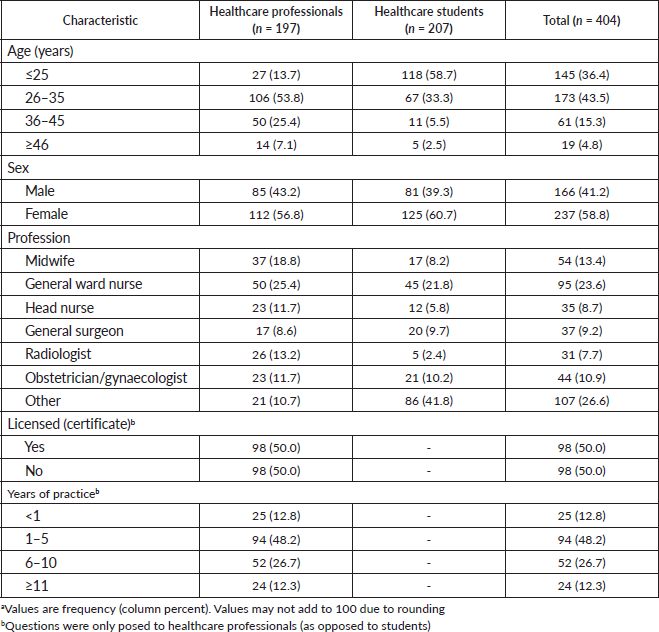
Eighty-nine percent of included participants had a good knowledge of BC, correctly answering at least 9/18 questions pertaining to BC risk factors, severity and burden, while 61% showed superior knowledge by answering at least 12/18 questions correctly. Five questions were answered correctly by less than 50% of the sample. Two were regarding risk factors: First birth occurring after mother is ≥30 years old (49%); Use of oral contraceptive pills (46%), while the others related to those-at-risk and preventability of the disease: BC is preventable (8%); BC is most common among women in their 20s (45%); Only women can get BC (46%) (Table 2). Healthcare professionals and students differed in their knowledge of risk factors; professionals were significantly more likely to recognise five (non-) risk factors: History of smoking (92% versus 82%); Family history of BC (97% versus 89%); No history of breastfeeding (82% versus 73%); Having multiple sex partners (non-risk factor; 80% versus 65%); Larger breasts (non-risk factor; 65% versus 49%). Students correctly identified two risk factors at a significantly higher rate than healthcare professionals: First birth occurring after mother is ≥30 years old (36% versus 63%); Use of oral contraceptive pills (30% versus 63%).
Table 2. Knowledge concerning BC risk factors, aetiology and prevention.
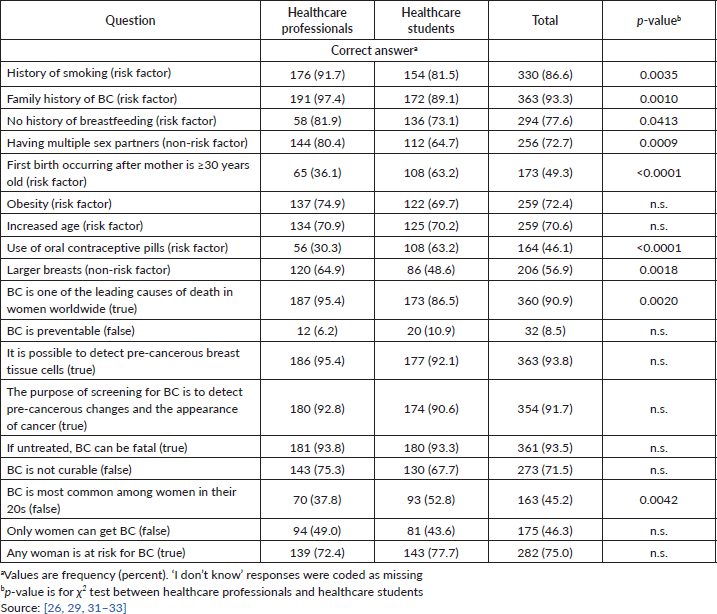
Respondents had relatively less knowledge of CC. Seventy-three percent of respondents correctly answered at least 10/19 questions pertaining to CC, and 56% correctly responded to at least 12/19 questions. In addition to this poor overall performance, responses to CC questions exhibited more heterogeneity; more questions had significantly different response patterns across professional and student groups when compared to BC (Table 3). Healthcare professionals were more likely to correctly answer CC risk factor questions across the board but were less likely to correctly answer the following questions about CC screening and presentation: CC can usually be found at an early stage because of the obvious symptoms (false; 23% versus 33%); CC is most common among women in their 20s (false; 43% versus 62%). Professionals with more than 5 years of practice were more likely to show good knowledge of CC than their newer professional counterparts (100% versus 93%; p = 0.02). Also of note, a small majority of respondents correctly identified that there is a licensed vaccine that can prevent CC; healthcare professionals were significantly more likely to identify the existence of such a vaccine (65% versus 42%). Additionally, only 26% and 43% of respondents correctly identified that poor personal hygiene and use of intrauterine devices were not risk factors for CC, respectively.
Table 3. Knowledge concerning CC risk factors, aetiology and prevention.
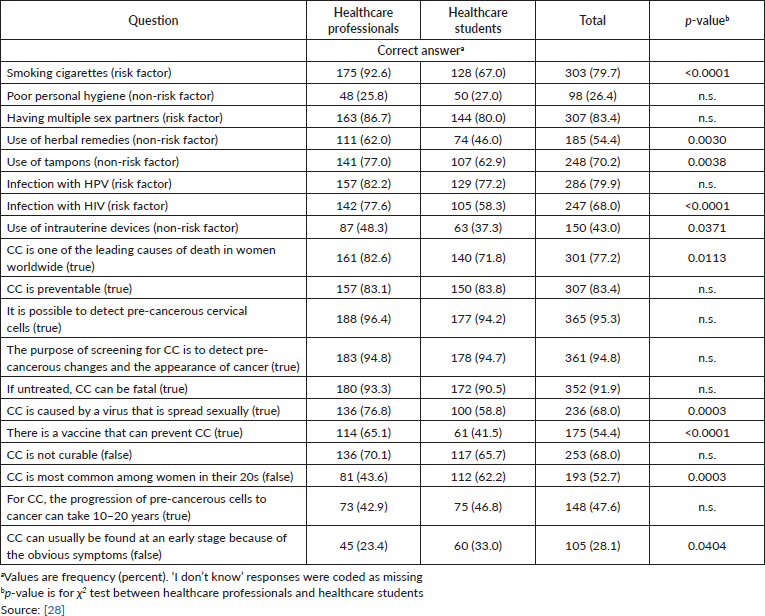
Attitudes towards screening were overwhelmingly positive for both cancers. Over 98% of respondents agreed that both BC and CC are serious diseases, that screening for both diseases is an essential part of women’s healthcare, and that a screening programme for both cancers should be initiated in their community (Table 4). Relative to patients’ other needs, however, respondents were not as concerned about BC and CC screening, with over 92% stating that their patients have more pressing concerns than cancer screenings. Respondents also agreed that a lack of resources inhibited screening, with over 96% reporting that they lacked two or more fiscal or technological resources required for screening. Among other barriers to screening, 30% of respondents reported patients refusing opportunities for BC or CC screens.
Table 4. Attitudes concerning BC, CC and barriers to screening.
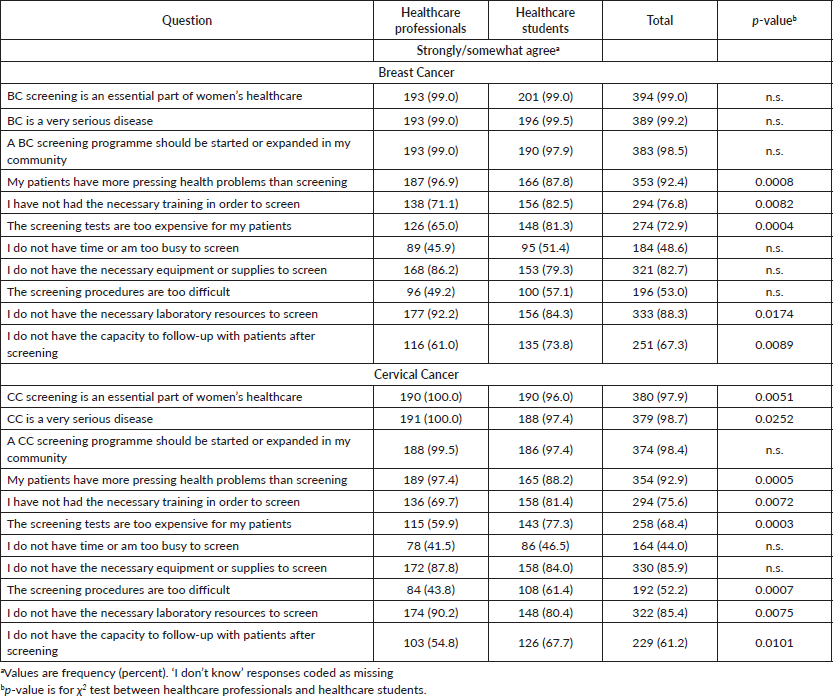
Most respondents reported not having cared for BC and CC and precancerous patients. About 24% reported having treated either BC or CC patients (Table 5), while 30% reported having ever conducted either a BC or CC screening examination (Figure 1). Healthcare professionals with more than 5 years of experience were more likely than other professionals to have conducted a CC screening procedure (32% versus 17%; p = 0.02), and although they more frequently performed BC screenings (27% versus 16%), this difference was not significant. Moreover, over 95% of respondents had a positive attitude towards the efficacy of BSEs (Table 6); 92% were confident that they could detect abnormalities in breasts, and about 79% recommend that their patients conduct breast-examinations and felt confident about their ability to teach the technique to patients.
Discussion
To the authors’ knowledge, this is the first study to investigate Somali healthcare professionals’ and students’ KAP towards BC, CC and screening for both diseases. A large majority (89%) of respondents demonstrated a good knowledge of BC prevention and screening, risk factors, severity and burden. This study provides evidence of Somali healthcare workers’ higher levels of BC knowledge compared to participants in nearby Northwest Ethiopia [34], Addis Ababa in Central Ethiopia [27, 35] and Eritrea [26]. As expected, healthcare professionals performed better than students at identifying BC risk factors. Surprisingly, a majority of healthcare professionals said that BC was most common in women in their 20s, potentially a reflection of growing trends of early-onset BC plaguing sub-Saharan African populations [36], and overwhelming majorities of both professionals (94%) and students (89%) stated that BC was a preventable disease. With regard to CC, a majority (73%) of healthcare professionals and students demonstrated good knowledge. Though lower than the BC scores, the current finding is higher than that of other sub-Saharan investigations in Tanzania and Côte d’Ivoire [37, 38], but lower than that of Ethiopia and Nigeria [25, 39, 40]. While only 54% of professionals and students knew that there was a vaccine available that could prevent CC, this is a higher rate than that identified in southern Ethiopia (36%) [25].
Table 5. Practices concerning BC and CC diagnosis and treatmentc.
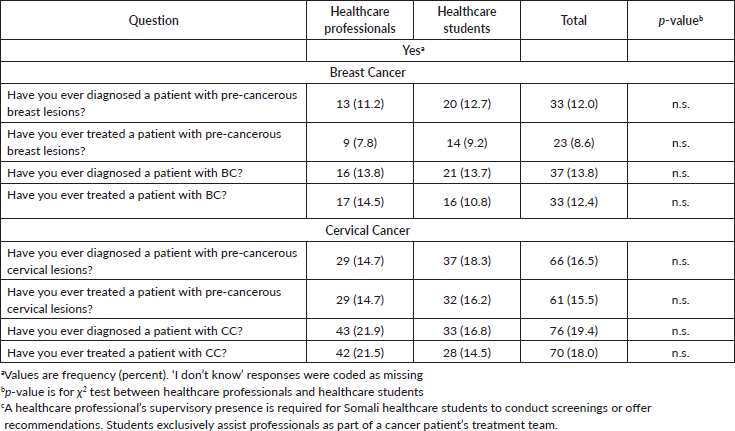
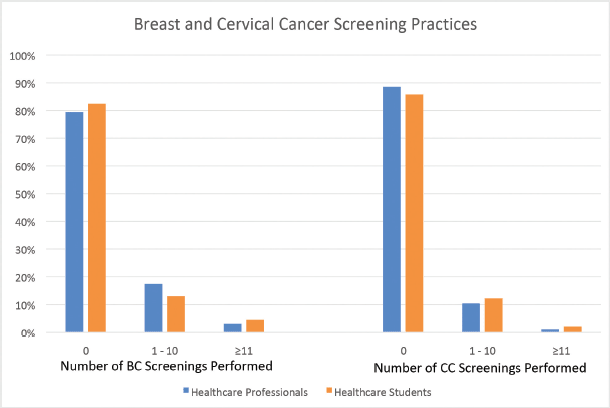
Figure 1. Proportion of medical doctors, nurses and midwives having performed BC and CC screening procedures. CC screening procedures included pap smear, HPV DNA testing, liquid-based cytology, visual inspection with acetic acid and visual inspection with Lugol’s solution.
Table 6. Attitudes and practices towards BSEc.
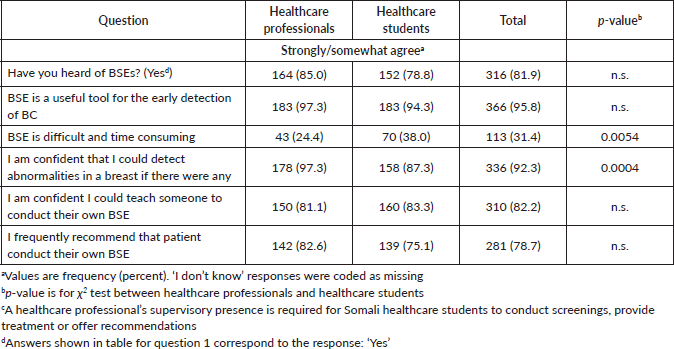
While Mogadishu-based medical universities’ curricula inform students about CC, BC, screenings and HPV, the widespread unavailability of screening equipment can make it difficult to reinforce these concepts with practice. It is therefore essential that medical education programmes all across Somalia incorporate lessons about risk factors and screening, as well as how to navigate sensitive conversations about women’s cancers with patients. In addition, the Somali Medical Association encourages attendance of biannual Continuing Medical Education events to reinforce established and introduce new concepts to graduated medical professionals [41]. These events may prove to be useful sites to incorporate lessons that help dispel misconceptions held by healthcare professionals, such as those identified in the present study surrounding BC preventability, CC risk factors and HPV vaccinations. Lamentably, the Continuing Medical Education events are only held in Somalia’s largest cities, and together with even greater unavailability of screening resources in rural areas and smaller cities, this gives reason to believe that healthcare professionals from other Somali provinces would demonstrate worse knowledge of both cancers and screening practices.
Attitudes towards screening of both diseases and of BSE proved remarkably positive. Though 99% and 98% of respondents stated that screening for BC and CC was an essential part of women’s healthcare, respectively, a lack of access to services necessary for prevention and early detection of both diseases was reported. Despite demonstrating this robust approval of screening, almost 70% of healthcare professionals and students disclosed having never conducted a screening for either disease, in part because over 97% reported a lack of access to essential screening services including laboratory equipment, money dedicated for screening tests and follow-up capacity. (A healthcare professional’s supervisory presence is required for Somali healthcare students to conduct screenings or offer recommendations; students exclusively assist professionals as part of a cancer patient’s treatment team.) An exception to this lack of screening practice was that of BSE, where 79% and 82% of respondents, respectively, reported frequently recommending that patients conduct BSEs and expressed confidence in their ability to teach the method. Without a comprehensive BC screening programme in place, widespread BSE may serve as an acceptable alternative for Somali women to become familiar with any changes in their breast, despite the method’s limitations.
While the availability of resources, both technological and human, reportedly played a substantial role in precluding healthcare workers from conducting screening, 30% of respondents reported a patient having refused screening for either cancer. These respondents concurred that patients refused screening for either cancer because it was looked down upon by friends or family, because they believed it would give them cancer and because they found it embarrassing, intrusive or painful, among other reasons. Studies aimed at evaluating BC and CC screening in the Somali context will therefore be essential – qualitative investigations aimed at uncovering the cultural nature of the stigma that inhibits screening for both cancers will be vital to effectively launch educational campaigns that dispel patients’ misconceptions to improve uptake of cancer screenings as their availability grows.
A monetary and technological investment is necessary to improve Somali healthcare workers’ ability to combat BC and CC – a needs assessment evaluating the current status and deficits of cancer screening infrastructure is indispensable for understanding where to direct new commitments from governmental and international institutions. Such an assessment could also help direct a dedication to comprehensive national HPV surveillance in Somalia, as data concerning HPV’s prevalence in at-risk populations or confirmed CC cases remain unavailable. Establishing robust HPV surveillance could incite organisations like GAVI, for which Somalia is eligible [42], to deliver aid in the form of HPV vaccinations and enhance primary and secondary CC prevention strategies.
This study was subject to several limitations. As the conducted investigation was cross-sectional and survey-based in nature, recall and social desirability biases are among the study’s potential limitations. The study utilised a purposive sampling technique to avoid neglecting any type of healthcare worker providing cancer care to Somali women, particularly midwives who play an invaluable role in providing reproductive health services across the nation [43]. It is not intended to be a representative sample of Somali healthcare workers and its generalisability is therefore limited. Lastly, a wave of COVID-19 cases plagued Somalia and the Mogadishu area in February and March of 2021, when the study was in the data collection stage; the added time and emotional strain may have influenced the selection of participants. We attempted to mitigate this by eliminating individuals who completed less than 85% of the survey, who may have been stressed for time and skipped past questions.
Conclusions
This study is the first of its kind to examine the KAP of Somali healthcare workers as it relates to BC, CC and screening. While knowledge of both diseases and screening was generally good, there remain areas for clear educational targeting to improve the quality of chronic care provided by healthcare professionals and students, such as the preventability of BC and the existence of a vaccine that can prevent CC. Attitudes toward screening for both diseases were all exceedingly positive, but failed to translate into practice due to inadequate resources and patient refusal. Attitudes toward BSE were also remarkably positive and did translate to clinical recommendations. To expand access and increase the affordability of Somalia’s chronic care management, future investments should prioritise the technology necessary to conduct screenings for both diseases, expanding access to HPV vaccines and establishing an HPV surveillance programme and understanding patients’ potential motivations for refusing screening at the current moment.
List of abbreviations
BC, Breast cancer; LMICs, Low- and middle-income countries; BSE, Breast self-examinations; CC, Cervical cancer; HPV, Human papillomavirus; KAP, Knowledge, attitudes and practices
Conflicts of interest
The authors declare that they have no conflicts of interests. This article is based on a thesis project for completion of graduation requirements for a Master’s in Public Health.
Funding
This was an unfunded study.
Authors’ contributions
LW contributed to conceptualisation, formal analysis, methodology, software, supervision, validation, visualisation and writing. DM contributed to conceptualisation, investigation, project administration, resources, supervision and writing. AH contributed to data curation, investigation, project administration, resources and supervision. NK and SA contributed to conceptualisation, formal analysis, software, visualisation and writing. AAM contributed to data curation, project administration, resources and writing. JA contributed to conceptualisation, validation, visualisation and writing. MAA contributed to conceptualisation, investigation, methodology, project administration, resources, supervision, validation and writing. KK contributed to conceptualisation, formal analysis, methodology, project administration, resources, supervision, validation and writing.
Ethics approval and consent to participate
This study received approval from the ethics board at SIMAD University’s Institute for Medical Research and was deemed exempt from review by the Yale IRB (ID #2000029594). Verbal informed consent was obtained by the researchers by way of a brief presentation regarding the investigation’s purpose, procedures and requirements for participation. Potential participants were made aware that participation was voluntary and could be withdrawn at any moment, that their responses would be anonymous and confidential, and that their participation would in no way impact their relationship with their employer. Data collectors received monetary compensation for their time and effort.
Acknowledgments
The authors would like to thank the Hagarla Institute and SIMAD University for their support of our research.
Availability of data and materials
References
1. World Health Organization – IARC (2020) Cancer today: data visualization tools for exploring the global cancer burden 2020 [https://gco.iarc.fr/today/home]
2. Jemal A, Center MM, and DeSantis C, et al (2010) Global patterns of cancer incidence and mortality rates and trends Cancer Epidemiol Biomarkers Prev 19(8) 1893–1907 https://doi.org/10.1158/1055-9965.EPI-10-0437 PMID: 20647400
3. Youlden DR, Cramb SM, and Dunn NA, et al (2012) The descriptive epidemiology of female breast cancer: an international comparison of screening, incidence, survival and mortality Cancer Epidemiol 36(3) 237–248 https://doi.org/10.1016/j.canep.2012.02.007 PMID: 22459198
4. Sankaranarayanan R, Swaminathan R, and Brenner H, et al (2010) Cancer survival in Africa, Asia, and Central America: a population-based study Lancet Oncol 11(2) 165–173 https://doi.org/10.1016/S1470-2045(09)70335-3
5. Brand NR, Qu LG, and Chao A, et al (2019) Delays and barriers to cancer care in low- and middle-income countries: a systematic review Oncologist 24(12) e1371–e1380 https://doi.org/10.1634/theoncologist.2019-0057 PMID: 31387949 PMCID: 6975966
6. Rivera-Franco MM and Leon-Rodriguez E (2018) Delays in breast cancer detection and treatment in developing countries Breast Cancer 12 1178223417752677 PMID: 29434475 PMCID: 5802601
7. Parsa P, Kandiah M, and Abdul Rahman H, et al (2006) Barriers for breast cancer screening among Asian women: a mini literature review Asian Pac J Cancer Prev 7(4) 509–514
8. U.S. Preventive Services Task Force (2002) Screening for breast cancer: recommendations and rationale Ann Intern Med 137(5 Part 1) 344–346 https://doi.org/10.7326/0003-4819-137-5_Part_1-200209030-00011 PMID: 12204019
9. Sideeq K, Ayoub T, and Sailm Khan SM (2017) Breast self-examination: assessing its knowledge attitude and practice among ethnic Kashmiri females Int J Community Med Public Health 4(9) 5 https://doi.org/10.18203/2394-6040.ijcmph20173830
10. Karayurt Ö, Özmen D, and Çetinkaya AÇ (2008) Awareness of breast cancer risk factors and practice of breast self examination among high school students in Turkey BMC Public Health 8(1) 359 https://doi.org/10.1186/1471-2458-8-359 PMID: 18928520 PMCID: 2587470
11. McCready T, Littlewood D, and Jenkinson J (2005) Breast self-examination and breast awareness: a literature review J Clin Nurs 14(5) 570–578 https://doi.org/10.1111/j.1365-2702.2004.01108.x PMID: 15840071
12. Kashgari RH and Ibrahim AM (1996) Breast cancer: attitude, knowledge and practice of breast self examination of 157 saudi women J Family Community Med 3(1) 10–13 https://doi.org/10.4103/2230-8229.98568 PMID: 23008542 PMCID: 3437138
13. Budden L (1995) Young women’s breast self-examination knowledge and practice J Community Health Nurs 12(1) 23–32 https://doi.org/10.1207/s15327655jchn1201_3 PMID: 7897468
14. Arbyn M, Weiderpass E, and Bruni L, et al (2020) Estimates of incidence and mortality of cervical cancer in 2018: a worldwide analysis Lancet Glob Health 8(2) e191–e203 https://doi.org/10.1016/S2214-109X(19)30482-6 PMCID: 7025157
15. Jedy-Agba E, Joko WY, and Liu B, et al (2020) Trends in cervical cancer incidence in sub-Saharan Africa Br J Cancer 123(1) 148–154 https://doi.org/10.1038/s41416-020-0831-9 PMID: 32336751 PMCID: 7341858
16. The World Bank Life expectancy at birth, female (years) – Sub-Saharan Africa, Somalia [https://data.worldbank.org/indicator/SP.DYN.LE00.FE.IN?locations=ZG-SO]
17. Sharma R (2020) Breast cancer burden in Africa: evidence from GLOBOCAN 2018 J Public Health (Oxf) 43 763–771 https://doi.org/10.1093/pubmed/fdaa099
18. Gele AA, Qureshi SA, and Kour P, et al (2017) Barriers and facilitators to cervical cancer screening among Pakistani and Somali immigrant women in Oslo: a qualitative study Int J Womens Health 9 487–496 https://doi.org/10.2147/IJWH.S139160 PMID: 28740435 PMCID: 5505544
19. Elkheir N, Sharma A, and Cherian M, et al (2014) A cross-sectional survey of essential surgical capacity in Somalia BMJ Open 4(5) e004360 https://doi.org/10.1136/bmjopen-2013-004360 PMID: 24812189 PMCID: 4024602
20. Gele AA, Ahmed MY, and Kour P, et al (2017) Beneficiaries of conflict: a qualitative study of people’s trust in the private health care system in Mogadishu, Somalia Risk Manag Healthc Policy 10 127–135 https://doi.org/10.2147/RMHP.S136170 PMID: 28831275 PMCID: 5548277
21. Ali AM, Handuleh J, and Patel P, et al (2014) The most fragile state: healthcare in Somalia Med Confl Surv 30(1) 28–36 https://doi.org/10.1080/13623699.2014.874085
22. Warsame A, Handuleh J, and Patel P (2016) Prioritization in Somali health system strengthening: a qualitative study Int Health 8(3) 204–210 https://doi.org/10.1093/inthealth/ihv060
23. Simms KT, Steinberg J, and Caruana M, et al (2019) Impact of scaled up human papillomavirus vaccination and cervical screening and the potential for global elimination of cervical cancer in 181 countries, 2020-99: a modelling study Lancet Oncol 20(3) 394–407 https://doi.org/10.1016/S1470-2045(18)30836-2 PMID: 30795950
24. Bruni L, Albergo G, and Serrano B, et al (2019) Human Papillomavirus and Related Diseases in Somalia. Summary Report. ICO/IARC Information Centre on HPV and Cancer (HPV Information Centre)
25. Dulla D, Daka D, and Wakgari N (2017) Knowledge about cervical cancer screening and its practice among female health care workers in southern Ethiopia: a cross-sectional study Int J Women’s Health 9 365–372 https://doi.org/10.2147/IJWH.S132202
26. Andegiorgish AK, Kidane EA, and Gebrezgi MT (2018) Knowledge, attitude, and practice of breast cancer among nurses in hospitals in Asmara, Eritrea BMC Nurs [Internet] 17 33 [http://europepmc.org/abstract/MED/30083079; https://doi.org/10.1186/s12912-018-0300-4] https://doi.org/10.1186/s12912-018-0300-4 PMID: 30083079 PMCID: 6069844
27. Zeru Y, Sena L, and Shaweno T (2019) Knowledge, attitude, practice, and associated factors of breast cancer self-examination among urban health extension workers in Addis Ababa, Central Ethiopia J Midwifery Reprod Health 7(2) 1682–1692
28. Kress CM, Sharling L, and Owen-Smith AA, et al (2015) Knowledge, attitudes, and practices regarding cervical cancer and screening among Ethiopian health care workers Int J Womens Health 7 765–772 PMID: 26261427 PMCID: 4527576
29. Haji-Mahmoodi M, Montazeri A, and Jarvandi S, et al (2002) Breast self-examination: knowledge, attitudes, and practices among female health care workers in Tehran, Iran Breast J 8(4) 222–225 https://doi.org/10.1046/j.1524-4741.2002.08406.x PMID: 12100114
30. SAS Institute Inc (2021) SAS/IML® 14.1 User’s Guide (Cary: SAS Institute Inc)
31. Centers for Disease Control and Prevention (CDC) (2020) What are the risk factors for breast cancer? https://www.cdc.gov/cancer/breast/basic_info/risk_factors.htm#:~:text=Older%20women%20who%20are%20overweight,for%20more%20than%20five%20years]
32. Cancer.net Editorial Board (2021) Breast cancer: risk factors and prevention Cancer.net [https://www.cancer.net/cancer-types/breast-cancer/risk-factors-and-prevention]
33. Breastcancer.org (2020) Breast cancer risk factors Breastcancer.org [https://www.breastcancer.org/risk/factors]
34. Azage M, Abeje G, and Mekonnen A (2013) Assessment of factors associated with breast self-examination among health extension workers in West Gojjam Zone, Northwest Ethiopia Int J Breast Cancer 2013 814395 https://doi.org/10.1155/2013/814395 PMID: 24298389 PMCID: 3835626
35. Lemlem SB, Sinishaw W, and Hailu M, et al (2013) Assessment of knowledge of breast cancer and screening methods among nurses in university hospitals in Addis Ababa, Ethiopia, 2011 ISRN Oncol 2013 470981 PMID: 23986873 PMCID: 3748754
36. Sighoko D, Kamate B, and Traore C, et al (2013) Breast cancer in pre-menopausal women in West Africa: analysis of temporal trends and evaluation of risk factors associated with reproductive life Breast 22(5) 828–835 https://doi.org/10.1016/j.breast.2013.02.011 PMID: 23489760
37. Urasa M and Darj E (2011) Knowledge of cervical cancer and screening practices of nurses at a regional hospital in Tanzania Afr Health Sci 11(1) 48–57 PMID: 21572857 PMCID: 3092321
38. Tchounga BK, Jaquet A, and Coffie PA, et al (2014) Cervical cancer prevention in reproductive health services: knowledge, attitudes and practices of midwives in Côte d’Ivoire, West Africa BMC Health Serv Res 14(1) 165 https://doi.org/10.1186/1472-6963-14-165
39. Ekine AA, West OL, and Gani OO (2015) Awareness of female health workers and non health workers on cervical cancer and cervical cancer screening: South – South, Nigeria Int J Med Sci Clin Invention 2(2)
40. Oche MO, Kaoje AU, and Gana G, et al (2013) Cancer of the cervix and cervical screening: current knowledge, attitude and practices of female health workers in Sokoto, Nigeria Int J Med Med Sci 5(4) 184–190
41. Somalia Medical Association (2019) CMEs sma.org.so [https://sma.org.so/others-2/]
42. GAVI (2020) Eligibility gavi.org [https://www.gavi.org/types-support/sustainability/eligibility?gclid=CjwKCAjw6qqDBhB-EiwACBs6x2rQ-btvbD7XluJ4Wq6H_6OjxkeIpWB7hjZ3jXZJ-oINWlMIbT62_hoCqNQQAvD_BwE]
43. World Health Organization (2013) Midwives at heart of Somalia’s new reproductive health strategy 2013 [https://www.who.int/features/2013/somalia_skilled_birth_attendants/en/]






